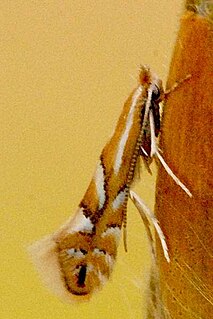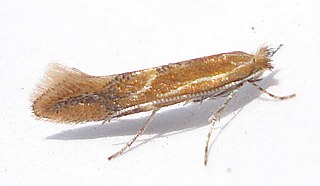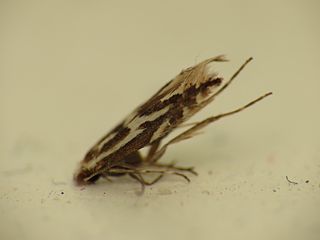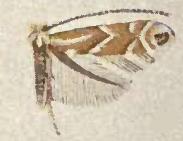
Gracillariidae is an important family of insects in the order Lepidoptera and the principal family of leaf miners that includes several economic, horticultural or recently invasive pest species such as the horse-chestnut leaf miner, Cameraria ohridella.

Cameraria is a genus of moths in the family Gracillariidae, which includes many species of leaf miners. One of the best known species is the horse-chestnut leaf miner, Cameraria ohridella.

Phyllonorycter maestingella is a moth of the family Gracillariidae. It is found in Europe, Russia and British Columbia, Canada.

The aspen leaf blotch miner moth is a moth of the family Gracillariidae. It is found in most of Europe. It is also present in Turkey and North America.

Phyllonorycter is a genus of moths in the family Gracillariidae.

The spotted tentiform leafminer is a moth of the family Gracillariidae. It is known from all of Europe, east to Ukraine and central Anatolia. It is also known throughout North America including Nova Scotia, Quebec, Ontario, Wisconsin and California.
Phyllonorycter latus is a moth of the family Gracillariidae. It is probably widespread throughout the western United States, but only known from Inyo County in California and Grand and Alamosa counties in Colorado.

Phyllonorycter foliolosi is a moth of the family Gracillariidae. It is endemic to the Canary Islands and is known from La Palma and Tenerife.

The European oak leaf-miner or Zeller's midget is a moth of the family Gracillariidae. It is found in Europe south of the line running from Ireland, through Great Britain, Denmark to Ukraine. It is also found in Macaronesia. It is an introduced species in New Zealand and Australia.
Phyllonorycter erugatus is a moth of the family Gracillariidae. It is known in the United States from widely scattered localities from Santa Clara County near sea level in mid-coastal California north to southern Alaska and west to the Rocky Mountains of Colorado to elevations of 2,800 meters.

Phyllonorycter apicinigrella is a moth of the family Gracillariidae. It is found along the western coast of the United States from San Luis Obispo County, California, north to Whatcom County in extreme north-western Washington.
Phyllonorycter farensis is a moth of the family Gracillariidae. It is known from the Faro River Reserve in Cameroon and the southern part of the Democratic Republic of the Congo.
Phyllonorycter koreana is a moth of the family Gracillariidae. It is known from Korea.
Phyllonorycter nepalensis is a moth of the family Gracillariidae. It is known from the Nepal.

Phyllonorycter albanotella is a moth of the family Gracillariidae. It is known from Québec in Canada and Illinois, Kentucky, Ohio, Texas, Maine, Vermont and Connecticut in the United States.

Phyllonorycter tritaenianella is a moth of the family Gracillariidae. It is known from Québec in Canada and Illinois, Kentucky, Maine, Michigan, New York, Connecticut and Massachusetts in the United States.
Phyllonorycter aberrans is a moth of the family Gracillariidae. It is known Ohio, Florida, Kentucky, Missouri, Arkansas, South Carolina and Tennessee in the United States.

Lithocolletinae is a subfamily of insects in the moth family Gracillariidae. It is distributed worldwide, with most species in temperate regions.

Annette Frances Braun (1884–1978) was an American entomologist and leading authority on microlepidoptera, kinds of moths. Her special interest was moths whose larvae live as leaf miners.







